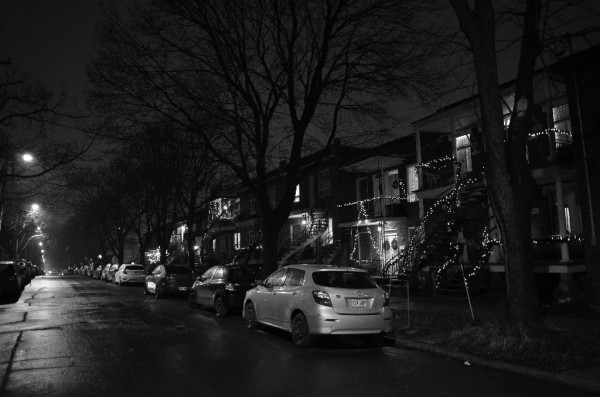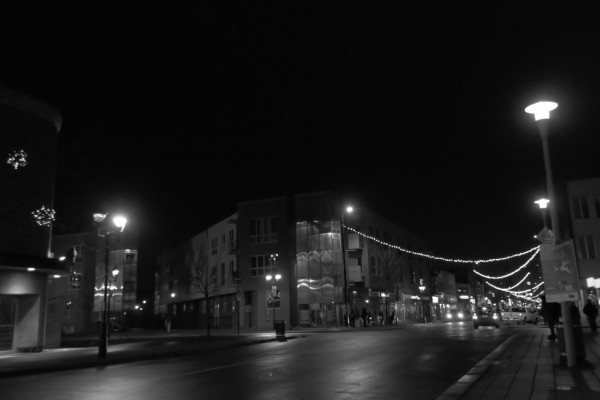The city street as “type of place”
In my last post I looked at the street from the point of view of experiencing it in moments of heightened awareness of its physical site at the crossing of two narratives: the historic past and the present moment.
In this post I will touch upon the way a city street draws its meaning from being a “type of place”, from its physical set up, its activity and people encountered, its “class”, etc … mainly from “reading” the buildings that border it.
For example: residential, industrial, business, mixed occupancy buildings will translate into residential, industrial, shopping streets … or districts.
Of course types of activities, noise level, air pollution, etc. help in qualifying the type of street.
A residential “Community Street”
In the feature image, I sensed what appeared to be the tight edge of a residential bloc huddle to have a particular sense of physical unity and social unity.
Seen from a fifth floor point of view, that bloc edge seemed to be possessed of a formal “community” feeling: community of architecture, of front yard treatment, of window treatment, etc.
The street along that edge contrasts with a busy, noisy, trans-island feeder at its north, and transitions at its south with a local one way east-west local street providing privileged bicycle and pedestrian traffic to central recreational facilities one can sense from the tree mass behind the residential bloc.
In the image you can tell from its sedate orderly, yet ornately varied and classy, English row house style architecture, that it is a street lived on by people of relative wealth respectful of tradition in building and in manners … a street that speaks of a “community of status and language” characteristic of the anglophone Town of Westmount.
Note the single entry doors providing access to the two floor townhouses in place of the usual exterior stair of the popular ordinary two units duplex.
If the above sounds like a real estate agent description of the area… that is why:
The social and economic self consciousness of residents of this type of neighborhood was made clear to me a few years ago; not long after moving into an upper duplex apartment in the francophone Town of Outremont, I remember being asked point blank by a neighbor walking his dog, whether we had bought the duplex we had moved in, or were we just renting!
You get my drift: A Street is a social type of place, not just an instrumental space.
A neighborly “Christmas Street”
Around the Holiday Season I searched for what is sometimes referred to as a “Christmas Street” i.e. an ordinary street turning into a special type of place when decorated block solid in a spirit of neighborly togetherness. (Peacock Lane in Portland, Ore. is an extreme example)
When I asked my photography colleague B.K. if he knew of any, he promptly referred me to East Montreal, not far from where his parents had first settled in the late forties, now a popular district of mixed industrial and residential occupancies, where he remembered distinctly seeing such streets and such spirit at Christmas.
A private version
The extent of decoration does not measure to a street tradition but is certainly an expression of good neighborliness. A street where being a neighbor would mean a bit more than just spatial proximity, and more like what is meant in the expression “good neighbor Joe”.
The degree and type of decoration do not seem to be orchestrated for any particular effect nor do they seen to be the expression of some kind of competition … they seem rather to be a neighborly response to that spirit of the holiday season mentioned in my last post: guide the visitor from the street to the door and make him feel welcomed inside.
What is particular of course to this street is that this spirit seems to have extended from the particular homes to whole sections of the street … making it a “neighborhood street” as my friend B.K. would say, something of an “urban room” where one would sense “entering” and feel “inside”… at least at Christmas time.
A public version
The strings of light bulbs hung from light posts is a street based business community response to the Holiday Season, hoping to attract clients to that stretch of street, one of the first to come out eastward from the historical core of the city.
Not an original way of “marking” a place, since we can see it done with flags etc. hung from such wires over stretches of streets identified with various social or ethnic groups on particular parade days etc.
The canopy effect has a powerful appeal that can influence one to remain within the covered area, the eastern most limit of which was set historically by railroad tracks that used to cross the street, from right to left in the photo, and slice through the dark gaping hole to the left on its way to service a now abandoned industrial area.
The way the railroad right of way has been developed as a pedestrian promenade and public square bordered by new residential and commercial development is best shown in the daytime panoramic photo collage below.
At night, the contrast between the lit up public commercial areas and the darkened private residential and promenade areas is a striking aspect of what I call an “urban set piece” (my translation from the French urban design concept of Pièce urbaine) that will be presented, analyzed and discussed next post.
Let us for now summarize the poetic dimensions of the street as “type of place” as presented here:
- it is a place with a sense of social and spatial unity and character which does not erase expressions of individuality nor of functional variety.
- it is a place which remains in one’s memory for the impression it makes on us due to its architectural and social qualities, its sense of arresting presence and for the occasional historically based environmental surprise.
…to be continued!
All photographs credit Maurice Amiel
